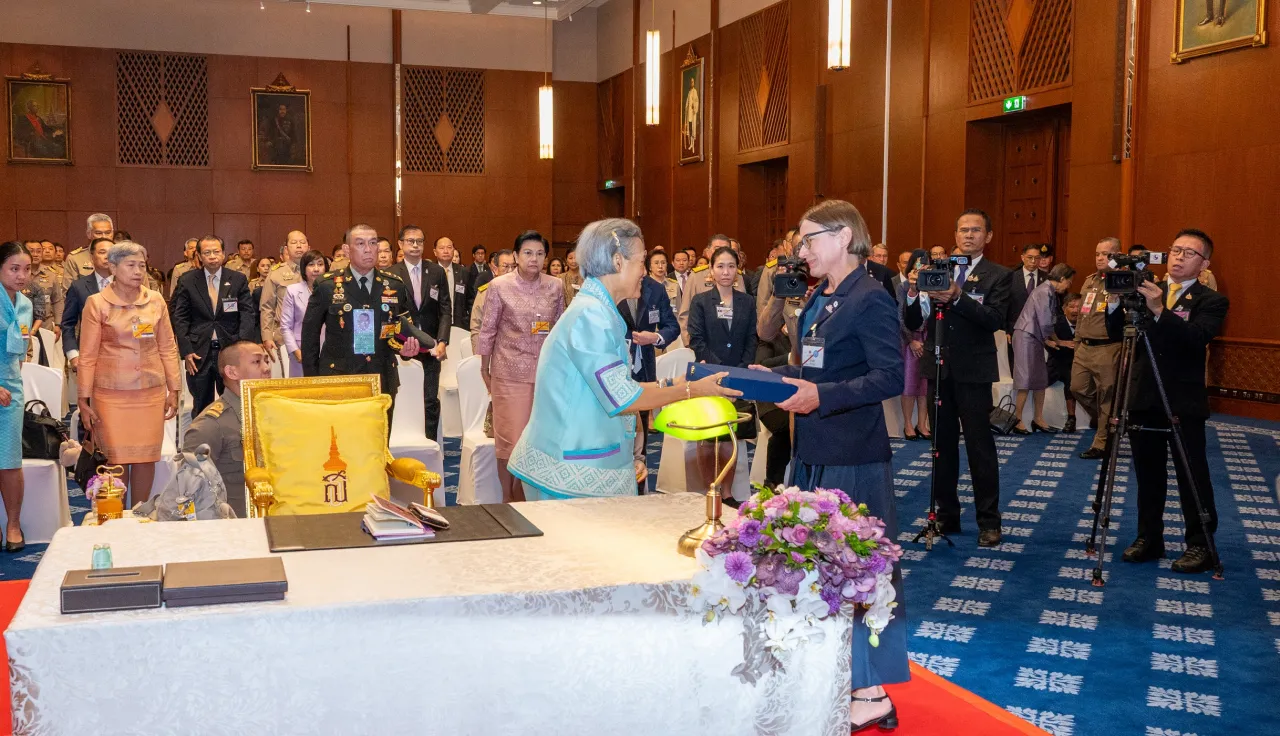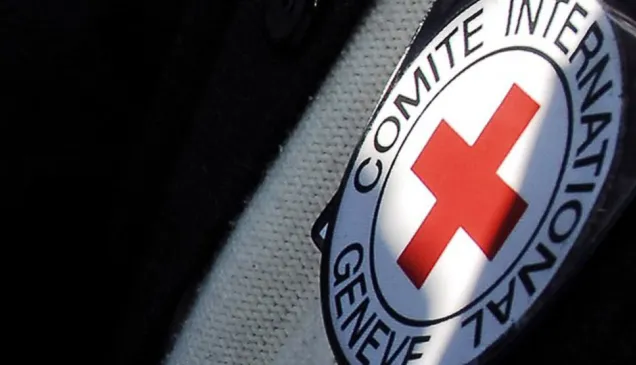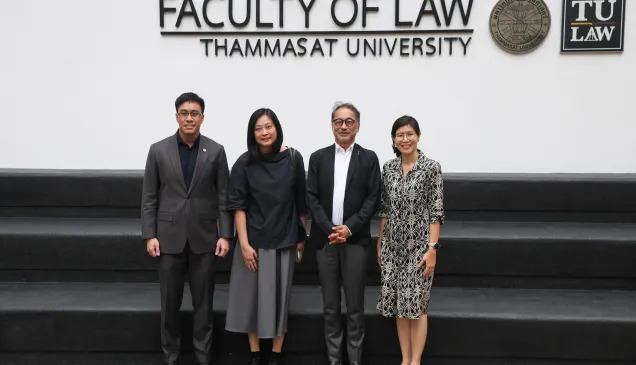Your Royal Highness Princess Maha Chakri Sirindhorn,
Excellencies,
Ladies and gentlemen,
It is a great honour to be with you today. Let me begin by expressing my sincere gratitude to Your Royal Highness for the kind invitation to speak at this esteemed event.
In times of crisis, the commitment of the Thai Red Cross to providing humanitarian assistance is deeply admirable, and I wish to thank you for your efforts. I am grateful for the years of collaboration and partnership in responding to emergencies and in advancing the protection of civilians in situations of armed conflict.
I commend Her Royal Highness, the Ministry of Foreign Affairs, and the Thai Red Cross for creating and sustaining one of the longest-standing platforms dedicated to educating audiences about the rules of war.
For more than 20 years, this distinguished lecture series has shown an enduring commitment to promoting IHL, fostering dialogue between international experts and Thai society, and upholding the humanitarian values enshrined in the Geneva Conventions.
The strength of international humanitarian law increases with public awareness of its importance and with the political weight that a country’s leadership attaches to it.
Lecture series like these play an important role in keeping the protective power of the rules of war imprinted into our collective conscience. The focus on the Geneva Conventions is crucial at a time when war is becoming more widespread, and when international law and multilateral treaties are under great strain.
The reality can’t be ignored, not today: we are living in a decade defined by war.
The ICRC currently classifies approximately 130 armed conflicts. This is more than we recorded last year, and far more than in previous decades.
While the number of countries experiencing armed conflict remains relatively stable, the number of simultaneous or newly escalating conflicts within them is growing. Many are protracted and often last for generations.
Today’s wars are also marked by coalition warfare, the fragmentation of armed groups, and millions of civilians living under the control of non-state armed actors.
Above all, this decade is seeing an increase in wars between states, tectonic political shifts, blurring alliances, and rapid technological advancements, which together exacerbate the risk for more high-intensity conflicts with devastating humanitarian consequences.
As wars multiply and geopolitical divisions deepen, respect for international humanitarian law is in crisis, and with it, our shared humanity. Armed conflict is now the single greatest driver of humanitarian needs. Much of this suffering could have been prevented had the rules of war been better respected.
The ICRC works on frontlines across the world. We know war intimately, and bear witness every day to the scars it carves into people, families, and communities.
In Myanmar, the humanitarian situation remains dire after decades of fighting, compounded by a devastating earthquake in March of this year. Hostilities persist and, in some places, have intensified. Meanwhile, restrictions on the movement of people and goods continue to limit access to essential services for many communities such as those in Rakhine.
Nowhere in Gaza is safe anymore. What we see there surpasses any acceptable legal or moral standards. Civilians are being killed and injured in their homes, in hospital beds, and while searching for food and water. Children are dying because they do not have enough to eat. The entire territory has been reduced to rubble. Warfare conducted indiscriminately as well as extreme restrictions on humanitarian aid have made conditions unliveable and devoid of human dignity. At the same time, hostages remain in captivity, despite the clear prohibition of hostage-taking under international humanitarian law.
Large-scale drone and missile attacks in the Russia-Ukraine international armed conflict are killing and injuring civilians far from the frontlines. Essential infrastructure is being destroyed. More than 146,000 cases of missing people – both military and civilian – have been reported to the ICRC as of the end of July.
In Sudan, civilians face an unrelenting nightmare of death, destruction, and displacement.
And after nearly four decades of war in Afghanistan, civilians continue to be haunted by mines, unexploded ordnances, and abandoned improvised explosive devices.
The situation in Syria illustrates one of the most heartbreaking and enduring consequences of prolonged conflict: the unresolved fate of the missing. The ICRC has registered over 36,000 missing people. This is likely just a fraction of the true number. If the ICRC had sustained access to all places of detention throughout the conflict, many of these cases might have been resolved or even prevented. Still today, water supply and electricity are at risk of collapse. At the same time, the recent violence along the coast and southern Syria underscores how the country’s path to peace is fragile – and how quickly clashes can erupt.
The scale of human suffering – in Gaza, Myanmar, Ukraine, Sudan, Afghanistan, Syria and dozens of other countries across the world – must never be accepted as inevitable. These are not unfortunate side effects of war, but consequences of a profound failure to uphold international humanitarian law.
They are the results of political failure.
When wars are fought with the mentality of “total victory” or “because we can” a dangerous permissiveness takes root – one where the law is bent to justify killing rather than prevent it. The Geneva Conventions were created specifically to prevent senseless suffering and death.
When hostilities are carried out indiscriminately and when violence is left unchecked, the consequences are catastrophic. Death and destruction become the norm, and not the exception.
In a highly interconnected world, unrestrained violence rarely remains confined to a single battlefield. It reverberates. When the world tolerates unbridled aggression in one conflict, it signals to the others – militaries, non-state armed groups, and their allies – that such behaviour is acceptable elsewhere.
As conflicts escalate, so too does the weaponization of information. Wars are fought today not only on the ground, but also in the digital arena, where harmful narratives and incendiary rhetoric are used to inflame tensions and justify violence.
Horrific events throughout history are rooted in a common element: dehumanisation. Stripping the humanity of others away creates an environment where torture, abuse, and killing is rationalised.
There is no such thing as a human animal. No people or territory should ever be erased from the face of the Earth.
In a world increasingly shaped by algorithms, the speed with which harmful narratives can spread is unprecedented – with dangerous real-world consequences.
We witness how genocidal vocabulary eventually translates into gruesome realities on the ground.
The vitriolic hatred embedded in such language strips away empathy, creating fertile ground for atrocities to take place. It renders brutality acceptable, or worse, seemingly inevitable.




